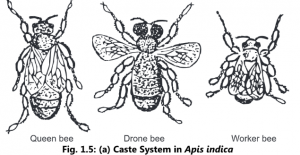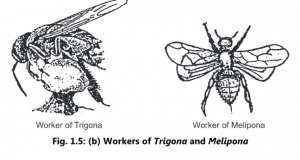Life Cycle of Honey Bee
The honey bees shows complete metamorphosis and thus are termed as holometabolan insects. The queen is functional female.
Nuptial Flight or Marriage Flight:
- The virgin queen copulates once only, at the beginning of her reproductive life. The first swarm is led by the old queen but the second swarm is led by the seven days old virgin queen which followed by the drones.
- The drones leave the hive in large numbers on warm, sunny days. The single function of drones is to fertilize the queens. Fertilization takes place only in clear air.
- The male is always killed in the act of fertilization, since he can eject the sperm by great pressure in his abdomen with the help of muscles and fluid pressure of blood.
- The queen receives spermatophores and stores in the spermatheca. Along with queen, died drone falls on the ground and the queen reaches the hive.
- This phenomenon of act of copulation is known as nuptial flight or marriage flight. After fertilization the queen generally lays one egg in one brood cell.
Egg:
- The eggs are pinkish coloured, elongated, cylindrical and generally attached at the bottom of the cell at the junction of any two walls. The eggs hatch in three days into white, legless grubs or larvae from the fertilized as well as unfertilized eggs.
- The larvae are provided with appropriate food and are inspected for their demands by nurse bees. Fertilized eggs are laid in worker or queen cells while unfertilized eggs are laid in drone cells.
Grub (Larva):
- The larvae are minute, white, apodous (legless). They grow and moult several times. Workers maintain a constant temperature of 35°C in the colony by either crowding or fanning.
- All the larvae are fed with protein and Vitamin-B rich royal jelly secreted by pharyngeal glands of worker bees for first 3-days. After 3-days worker and drone bees larvae are fed on a mixture of honey and pollen called ‘bee bread’.
- The grubs destined to produce queens receive the royal jelly throughout their life in abundant quantity. The queen and the drone grubs are larger in size.
Pupa:
- After S-days of feeding the cell is sealed and the grubs undergo pupation. It spins a thin silken cocoon and pupates completely.
- The pupa is exarate (i.e. legs are not adhered to the body). The worker, drone and queen pupae can be distinguished by examining the distance between eyes. In case of drone, eye meet over the head and in worker and queen the eyes are far apart.
- In the brood comb, the worker pupae has a flat capping with a dull and dry appearance and drone pupae has a convex capping with a hole at centre.
- The sealed pupae become tan and finally light brown in colour and after few hours later the pupal cuticle breaks and the adult bee emerges.
The distinguishing features of three castes are summarized in the following Table 1
Table 1: Morphological features distinguishing the three-castes of a honey bee

Adult: The emerged adult chew away the cell cap and crawls out to join the other bees as a member of the hive. The morphological features are described in earlier i.e. in social organization. Emergence of the young ones takes place after 3-weeks and they get busy in the indoor duties for about 2 to 3 weeks, later on they are sent for the outdoor duties.


- Period of development of larva and pupa differ amongst the castes. They are given in Table 2.

Colony Organization and Division of Labour
- The highly evolved social organisation of bees had been established before the existence of human race. Bees teach us the lesson of work and work with co-operation.
- A highly organised system of division of labour is found in colony of bees. The colony is highly polymorphic, comprising three varieties or castes-Queen, workers and drones.
- In a normal colony, there are one queen (Functional female), 25,000-35,000 workers (Sterile female) and 300-500 drones.
- The queen after nuptial flight (mating) lays both fertilized and unfertilized eggs. From unfertilized eggs male bees are developed which are termed as drones whereas from the fertilized eggs worker bees (Sterile females: are produced.
- The workers when feed on Royal jelly, develop in queen.
The Queen:
- The queen is the only perfectly developed fertile female. She is the mother of the colony and provided with well developed ovaries. Only one queen is present in each colony and feeds on Royal jelly. Egg
laying is the sole function of the queen throughout her active life span and lay 1,500 eggs in a day which is almost twice the weight of her body. - The queen is 15 to 20 mm in length and can be easily distinguished by her long tapering abdomen, short legs and wings. She is unable to produce wax or honey or gather pollen, nector.
- She mates with the drone in the air: (nuptial flight! only once in her life but in a single chance of fertilization, drone releases 2-crore sperms which are enough for the fertilization of the eggs at the time of laying by the female throughout her life span.
- In the whole life span of 2 to 5 years a queen lays about 15,00,000 eggs. When the queen loses its egg laying capacity, another worker of the same colony starts feeding on queen’s diet ie. Royal jelly, young and grubs develops into a new queen and is provided with the facilities of real queen.
- At the same time old queen may be driven out but sometimes some workers take objection that why the mother of the colony be driven out so ultimately they also come out with the mother.
- Sometimes when 2 or 3 queens are developed in a colony, only one take the position of the real queen and the others come out with some workers to establish new colonies.
- Queen provides the cohesive force which keeps the thousands of worker members of the colony together as a social unit. She does this by satisfying their demands for queen substance i.e. a substance secreted by the queen. This substance is most important in the maintenance of a colony and its social organisation.
- It has been found that a scent of fatty acid 9-oxodecenoic acid produced by queen’s mandibular glands attracts workers only over a very short distance which also inhibits queen rearing by the workers of her colony and development of ovaries of laying workers.
The Workers:
- These are imperfectly developed females from the fertilized eggs laid by the queen and live in a chamber called as “worker cell”. The workers takes 21 days in the development from egg to the adult and the total life span of a worker is about 6 weeks.
- The workers are unable to reproduce; but possess all the maternal instincts. They are responsible for all the work necessary for the maintenance and welfare of the colony.
- Division of labour among the workers is on a physiological basis. The indoor and outdoor duties of the colony are performed by the workers only due to having special structures for particular work as: (1) Long proboscis for sucking the nectar. (2) Strong wings for fanning. (3) Pollen basket for the collection of pollen. (4) Powerful sting to defend the colony against enemies. (5) Wax glands for wax secretion.
- Each worker bee performs different types of work in her life time and becomes fitted for various duties.
- During the first half of her life, she attends to indoor duties such as secretion of royal jelly, feeding of the brood, feeding the queen and attending on her, secreting bees wax, building combs, cleaning, ventilating, cooling and guarding the hive, evaporating nectar and storing honey.
- During the second half of her life lasting – 3 weeks she attends to outdoor duties as collects the nectar, pollen, propolis (qgum/bee glue) and water which are received and stored properly by the house bees.
- The field force of colony is divided into searchers and gatherers. The searcher bees fly around the surrounding area and bring back news of available food and communicate to gatherer bees by performing a round or tail wagging dance.
- The worker bees has been compared to a storage battery which can not be recharged. She is capable of performing a definite amount of work and when that is accomplished she dies.
- For example, in Chennai, due to a mild climate and plain variety Apis indica worker bee on average, lives for 50 days.
The Drone (Fertile mates):
- The drone is the male member of the honey bee colony which fertilizes the queen so called as ‘king’ of the colony.
- These are shorter and larger than worker bees and have greatly enlarged eyes. They take 24 days to develop from the egg to the adult stage. The drones are unable to gather food, but they eat a lot.
- They spend their time in enjoying the sun and fresh air. The drones are reared from unfertilized egg in large drone cell during the breeding season in spring and autumn when new queens are to be mated. They are driven out of the hive to die of starvation before the monsoon and winter.

- The normal life span of drones of A indica is 57 days in Chennai state.
- Drones are dependent and begging honey from the workers. During the swarming period, the drone follows the queen, copulates and dies after copulation.

